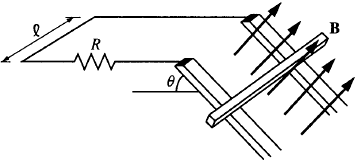
A conducting bar of mass m is placed on two long conducting rails a distance l apart. The rails are inclined at an angle θ with respect to the horizontal, as shown above, and the bar is able to slide on the rails with negligible friction. The bar and rails are in a uniform and constant magnetic field of magnitude B oriented perpendicular to the incline. A resistor of resistance R connects the upper ends of the rails and completes the circuit as shown. The bar is released from rest at the top of the incline. Express your answers to parts (a) through (d) in terms of m, l, θ, B, R, and g.
a. Determine the current in the circuit when the bar has reached a constant final speed.
b. Determine the constant final speed of the bar.
c. Determine the rate at which energy is being dissipated in the circuit when the bar has reached its constant final speed.
d. Suppose that the experiment is performed again, this time with a second identical resistor connecting the rails at the bottom of the incline. Will this affect the final speed attained by the bar, and if so, how? Justify your answer.